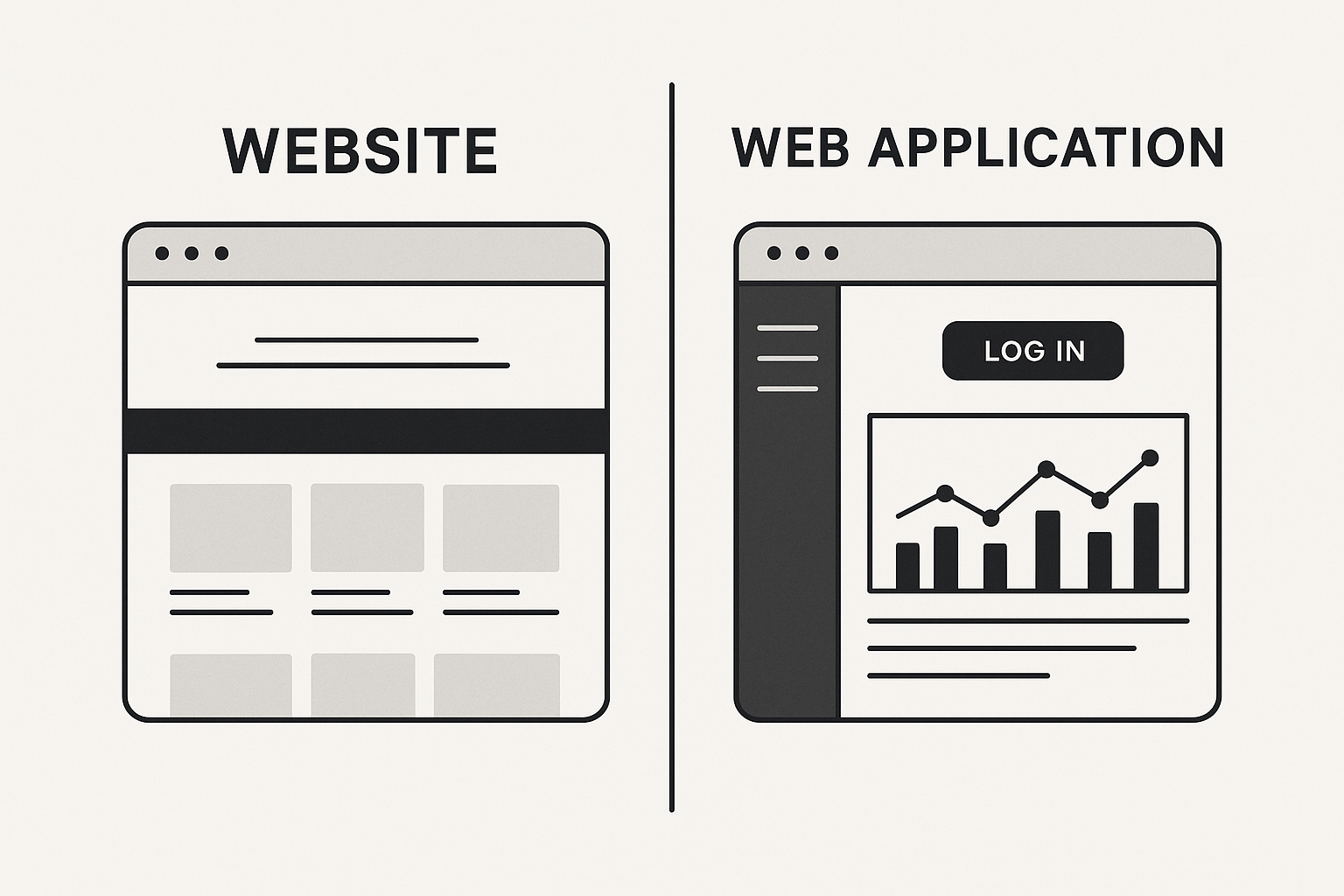Let me take you back to a coffee shop in 2018. I was building an online portfolio for a friend a simple website to showcase her art. Across the table, another friend was furiously coding something for a client. I asked, “What are you building?” He replied, “It’s a web app. You can log in, create an account, and design your own business cards.”
At that moment, the penny dropped: there’s a clear line between a website and a web application, and most people don’t realize where it is.
Here’s the thing:
The difference between a website and a web application isn’t just technical it’s about purpose, interactivity, and what you want users to actually do.
Table of Contents
- What Is a Website?
- What Is a Web Application?
- Key Differences: Website vs Web Application
- Myths, Mistakes, and Misconceptions
- Framework: How to Decide What You Need
- Actionable Tips & Checklist
- Real-World Examples
- Suggested Visuals
- Conclusion & Next Steps
What Is a Website?
A website is like a digital brochure. It’s mostly static, focused on delivering information or content to visitors.
Common uses:
- Company portfolios
- Blogs
- News sites
- Landing pages
Tip:
If your main goal is to inform, educate, or display content with minimal user input, a website is what you’re looking for.
Myth:
“All websites are interactive.”
Reality: Most are not. True interaction (beyond clicking links or submitting a basic form) is where web apps start.
What Is a Web Application?
A web application is a dynamic tool people use. Think online banking, Gmail, Canva, or your favorite project management tool. It responds to user input, processes data, and often requires authentication.
Common uses:
- Online banking
- Email platforms
- SaaS tools
- E-commerce dashboards
- Social networks
Tip:
If your project involves users logging in, creating accounts, managing data, or doing complex tasks, you’re probably building a web app.
Mistake:
Assuming you can just “add a login” to a website and call it a web application. Real web apps require secure data handling, backend logic, and interactive UX.
Key Differences: Website vs Web Application
| Feature | Website | Web Application |
| Purpose | Inform, display content | Enable user action, solve problems |
| User Interaction | Low (read, navigate) | High (input, CRUD operations) |
| Authentication | Rare | Common, often essential |
| Complexity | Usually simple | Usually complex |
| Content Management | Static or semi-static | Dynamic, user-driven |
| Development Stack | Frontend-heavy | Frontend + backend integration |
Checklist:
- Do users need to log in or manage their own data? (Web app)
- Is your primary goal to present info? (Website)
- Will users perform tasks that require saving, editing, or processing data? (Web app)
- Is the site mostly text, images, or videos with little personalization? (Website)
Myths, Mistakes, and Misconceptions
Myth 1:
“A modern website with some JavaScript is a web application.”
Reality: Websites can be dynamic without being true web apps. The core difference is the level of user interaction and data processing.
Myth 2:
“Web applications are only for big tech companies.”
Reality: Small businesses, schools, and even hobbyists build web apps think online booking or inventory systems.
Mistake:
Ignoring scalability and security.
Even simple web apps need robust data protection and should be built to handle growth.
Framework: How to Decide What You Need
- Define your primary goal:
- Is it to present or to enable?
- Map user journeys:
- Are users just reading or taking action?
- Assess technical needs:
- Will you need a database, authentication, or heavy processing?
- Estimate your budget and timeline:
- Apps require more time, testing, and ongoing updates.
- Plan for future growth:
- If your site might evolve into a tool, consider hybrid approaches from the start.
Actionable Tips & Checklist
- Start simple. Launch as a website, and upgrade to a web app only if needed.
- Use platforms like WordPress or Webflow for websites, and frameworks like React, Angular, or Vue for web apps.
- Prioritize user experience fast, clear, and intuitive interfaces always win.
- Plan for security and backups, especially for anything that handles personal data.
- Don’t reinvent the wheel. Use proven libraries and authentication solutions.
Real-World Examples
- Website:
Personal blog or news portal no user login, just browsing. - Web Application:
Google Docs users log in, create, edit, and share documents in real time. - Hybrid (Website with Web App Features):
E-commerce site product listings (website) + cart/checkout/user accounts (web app functionality).
Suggested Visuals
- Side-by-side diagram:
Show a basic informational website (e.g., a portfolio) next to an interactive web app (e.g., a dashboard with charts, login screen).
Alt text: “Diagram comparing a static website and a dynamic web application interface.” - Decision flowchart:
Visual flowchart: “Should you build a website or a web application?”
Alt text: “Flowchart to help readers choose between building a website or a web application based on their needs.” - Checklist graphic:
Quick checklist image: “Key features of websites vs web applications.”
Alt text: “Checklist graphic highlighting main differences between websites and web applications.”
Conclusion & Next Steps
If you’re still unsure, focus on your users’ needs what do you want them to do? Start with a website if you’re testing the waters. Move toward a web application when you need deeper interaction, data handling, or automation.
Ready to take the next step?
Subscribe for more practical guides, or contact us for a free consultation on your next digital project. And if this post helped clear things up, share it with someone still calling everything on the internet “just a website.”



